A Brief Review of Elasticity and Viscoelasticity for Solids 1 Introduction
A Brief Review of Elasticity and Viscoelasticity for Solids 1 Introduction
A Brief Review of Elasticity and Viscoelasticity for Solids 1 Introduction
Create successful ePaper yourself
Turn your PDF publications into a flip-book with our unique Google optimized e-Paper software.
H. T. Banks, S. H. Hu <strong>and</strong> Z. R. Kenz / Adv. Appl. Math. Mech., 3 (2011), pp. 1-51 25<br />
Note that the in-phase components produce no net work when integrated over a cycle,<br />
while the out-<strong>of</strong> phase components result in a net dissipation per cycle equal to:<br />
W = πalε 0 σ 0 sin(δ).<br />
Thus, <strong>for</strong> a purely elastic solid, the stress is in phase with the strain (δ = 0) <strong>and</strong> no<br />
energy is dissipated. On the other h<strong>and</strong>, motion in the viscoelastic solid produces<br />
energy loss.<br />
It is a common practice in engineering to use complex variables to describe the<br />
sinusoidal response <strong>of</strong> viscoelastic materials. Thus, instead <strong>of</strong> strain history (3.10), we<br />
specify the complex strain as<br />
ε ∗ = ε 0 exp(iωt).<br />
Then we obtain the following complex stress instead <strong>of</strong> stress described by (3.11)<br />
The above equation can be rewritten as<br />
where G ∗ is defined by<br />
σ ∗ = σ 0 exp ( i(ωt + δ) ) .<br />
σ ∗ = G ∗ ε ∗ ,<br />
G ∗ = σ 0<br />
ε 0<br />
exp(iδ) = σ 0<br />
ε 0<br />
cos(δ) + i σ 0<br />
ε 0<br />
sin(δ). (3.13)<br />
The characteristic parameter G ∗ is referred to as the complex dynamic modulus. We<br />
denote the real part <strong>of</strong> G ∗ by G ′ <strong>and</strong> the imaginary part <strong>of</strong> G ∗ by G”. That is,<br />
where<br />
G ∗ = G ′ + iG”, (3.14)<br />
G ′ = σ 0<br />
ε 0<br />
cos(δ), <strong>and</strong> G” = σ 0<br />
ε 0<br />
sin(δ).<br />
The coefficient G ′ is called the storage modulus (a measure <strong>of</strong> energy stored <strong>and</strong> recovered<br />
per cycle) which corresponds to the in-phase response, <strong>and</strong> G” is the loss modulus<br />
(a characterization <strong>of</strong> the energy dissipated in the material by internal damping) corresponding<br />
to the out-<strong>of</strong> phase response. The in-phase stress <strong>and</strong> strain results in elastic<br />
energy, which is completely recoverable. The π/2 out-<strong>of</strong>-phase stress <strong>and</strong> strain results<br />
in the dissipated energy.<br />
Remark 3.3. The relationship between the two transient functions, relaxation modulus<br />
G(t) <strong>and</strong> creep compliance J(t), <strong>for</strong> a viscoelastic material is given by<br />
∫ t<br />
0<br />
J(s)G(t − s)ds = t.

















